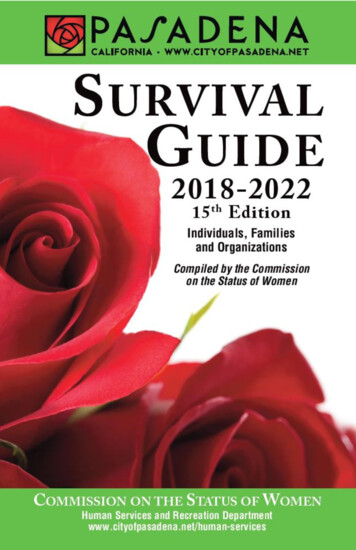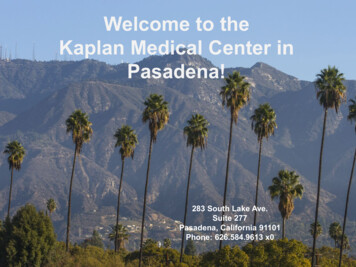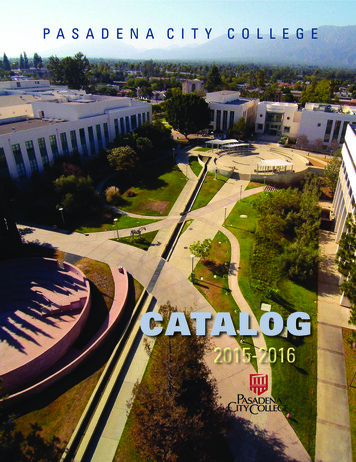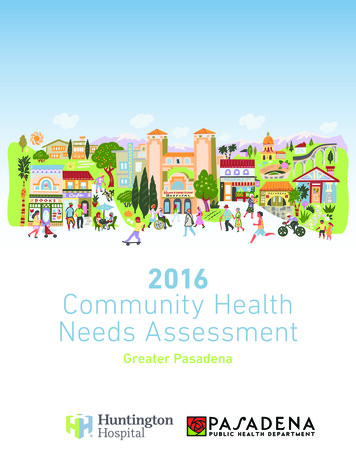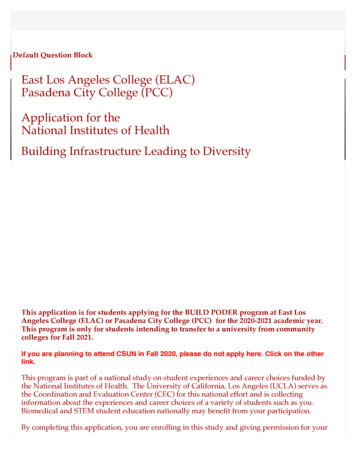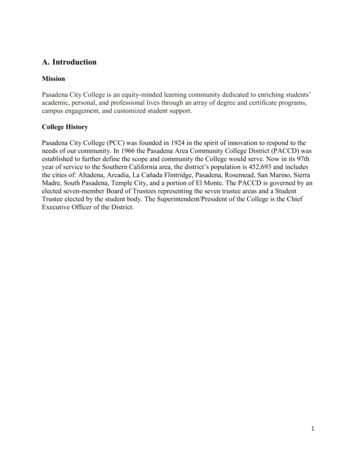
Transcription
A. IntroductionMissionPasadena City College is an equity-minded learning community dedicated to enriching students’academic, personal, and professional lives through an array of degree and certificate programs,campus engagement, and customized student support.College HistoryPasadena City College (PCC) was founded in 1924 in the spirit of innovation to respond to theneeds of our community. In 1966 the Pasadena Area Community College District (PACCD) wasestablished to further define the scope and community the College would serve. Now in its 97thyear of service to the Southern California area, the district’s population is 452,693 and includesthe cities of: Altadena, Arcadia, La Cañada Flintridge, Pasadena, Rosemead, San Marino, SierraMadre, South Pasadena, Temple City, and a portion of El Monte. The PACCD is governed by anelected seven-member Board of Trustees representing the seven trustee areas and a StudentTrustee elected by the student body. The Superintendent/President of the College is the ChiefExecutive Officer of the District.1
2
The College’s main campus has 30 buildings on a 53-acre site located at 1570 East ColoradoBoulevard in Pasadena. A satellite location, PCC at Foothill, is located at 3025 East FoothillBoulevard in Pasadena. It primarily houses the district’s noncredit programs, but for the last 6years has housed several of our Health Science programs as well. The College is preparing forthe construction of a new science building on the main campus.PCC at Rosemead is located at 4105 North Rosemead Boulevard in Rosemead. It offers a varietyof high demand courses and counseling services to students in the service area. The Collegerecently negotiated a lease for a building on the John Muir High School campus called PCCNorthwest at 1905 Lincoln Avenue, Pasadena, California. PCC Northwest offers generaleducation credit courses, including concurrent and dual enrollment courses for high schoolstudents, and it is preparing to offer noncredit programs. The College also operates a ChildDevelopment Center (CDC), located two blocks to the west of the main campus at 1324 EastGreen Street. The CDC provides childcare services for students and staff as well instructionalcoursework in Child Development. Pasadena City College offers a comprehensive selection ofdistance education and hybrid courses to meet the needs of our student population.PCC’s faculty, graduates, and former students, now numbering in the hundreds of thousands,have contributed greatly to business, education, industry, and the professions. The Collegeenrolls on average over 35,000 credit and about 3,500 noncredit students annually.Approximately 65 percent of the enrollment is drawn from outside the district’s boundaries,including out-of-state and international students. PCC is a Hispanic-Serving Institution thatsustains a diverse student body, with 51% of the total student population self-identifying asLatino. PCC is proud of its dedicated faculty and staff. As of Fall 2019, the College employed441 tenured and tenure-track full-time faculty, 78 administrators/managers, 402 classified staff,and 765 part time faculty.In addition to academics, PCC fosters athletic programs that include 16 intercollegiate athleticprograms, Men and Women’s Cross Country, Track and Field, Basketball, Swimming andDiving, and Soccer. The College also offers Women’s Water Polo, Women’s Volleyball,Women’s Softball, Women’s Badminton (which won back-to-back state championships in 2017and 2018), Men’s Baseball, and Men’s Football. Its most notable alum is Jackie Robinson – thefirst African American to play in major league baseball, as well as being a track, basketball, andfootball star during his time at PCC.Moreover, since 1947, PCC has educated and entertained the community via KPCC, its NationalPublic Radio-affiliated, award winning local news and cultural programming radio station.PCC’s talented faculty molds a student body amazingly rich in life experience and diversity. Anexperienced staff and administration promote an optimal and engaged educational environment,and the Trustees keep the college financially secure and in tune with the demands of the presentand future.3
Figure 1: PACCD Regional Population by EthnicityThe region PACCD serves is diverse but does not reflect the general demographics of the PCCstudent population. The regional population is 33% White, whereas the student population atPCC is only 14% White. The PCC student population is 50% Latinx and the region population isonly 26% Latinx. On the other hand, the PACCD region is 29% Asian and the PCC studentpopulation is 24% Asian.Figure 2: PACCD Regional Educational Attainment4
The educational attainment level in the PACCD region is relatively high with 52% of the regionpopulation having obtained an associate degree or more. Only 15% of the region population hasless than a high school diploma.Major Developments since the Last Self EvaluationPathways First Year Experience (FYE)PCC Pathways FYE was launched in 2011 to increase the success, persistence, and completionrates of students at Pasadena City College and close equity gaps. The program guaranteesstudents full schedules – including English and math/statistics courses – in the fall and springsemesters of their first year and provides them with the critical support they need outside of theclassroom. The program uses a prescriptive “guided pathway” approach, which includes acomprehensive set of support services, a first-year seminar course, and access to counselors,coaches, tutors, and a dedicated resource center.To maintain Pathways FYE status, students need to: attend a three-day summer orientation, called Jam carry a minimum of 12 units (full-time student status) enroll in math, English, and College 1, PCC’s first-year seminar course meet regularly with their success coach and counselor participate in various workshops and activities throughout their first yearStudents who meet all program requirements receive priority registration and assistance.Pathways FYE has grown each year since inception and in Fall 2019 served over 2, 800 firstyear, new-to-college students (approximately 60% of the incoming class). Pathways FYE5
students reflect PCC’s diverse student body: the 2019-20 cohort were 52% Latina/o/x, 27%Asian/Pacific Islander, 10% White, and 3% African American.The 2019 Pathways First Year Experience Report focuses on five key success indicators:cumulative credits earned, fall-to-fall persistence, transfer-level math and English completion,transfer status, and completion. On all five success indicators, Pathways FYE studentsoutperformed non-Pathways FYE students. Not only does Pathways FYE enrollment result ingreater success for students, but Latinx students outperformed their Latinx non-Pathways FYEpeers on all indicators.The program has grown steadily and continues to evolve. In 2019 PCC’sSuperintendent/President, Dr. Endrijonas, asked program staff to 1) continue to align the FYEwith the college’s Guided Pathways work and 2) serve all incoming students. In response,Pathways FYE now serves as the incubator for campus-wide adoption of the Guided Pathwaysframework including use of multiple measures assessment and caseload counseling,implementation of career communities (meta-majors), work-based learning, and the developmentof Career Center services. The Pathway FYE Center has been expanded and renamed the FirstYear Success Center, where students can receive tutoring, financial aid application and courseregistration support, as well visit with their success coaches and access computers and printers.A diverse group of campus leaders formed an inquiry group focused on addressing the needs ofour part-time students. The goal is to develop effective supports for students who are unable toattend college full-time, beginning in their critical first year. Their work is reflected in the one ofthe College’s Quality Focused Essays (QFE).Aspen Top 10Pasadena City College was named as one of 10 finalists for the 2016 and 2018 Aspen Prize forCommunity College Excellence, the nation’s signature recognition of high achievement andperformance in America’s community colleges. The college is honored to be considered a top 10Aspen institute and continues to expand the programs and services that brought us thisrecognition.#1 for TransferPCC is the number one school in California for transfers to California State University andUniversity of California. According to data released by the UC President’s Office and the CSUsystem, PCC sent 2,321 students to these four-year institutions in Spring and Fall 2019. PCC wasthe top college in the state for transfers to the CSUs, with 1,506 students moving from Pasadenato schools throughout the four-year CSU system. The top destinations for PCC transfers wereCSU Los Angeles, CSU Northridge, and Cal Poly Pomona.Student Support ServicesPCC is committed to investing resources in areas with the greatest need so that students reachtheir greatest potential, and intentionally provides support to students traditionally6
underrepresented in higher education. To assist students in meeting their goals, PCC has openedand sustained many services, including:Freeman Career and Completion CenterThe Robert G. Freeman Center for Career and Completion was established through a donationfrom local philanthropists and supporters of PCC. It offers guidance for students in exploringcareers, obtaining internships, and finding employment. The Freeman Center also assistsemployers in matching students to their workforce needs. It offers workshops and events ontopics such as leadership development, networking, personal branding, and interviewing.Here2Help Website:The Here2Help resource guide for students in need lists resources in the areas of transportation,support programs, financial assistance and employment, childcare and after school programs,Rapid Response Emergency Aid (RREA), health care, housing and shelter, and food andclothing.U-PASSU-PASS at PCC offers unlimited rides on the Metro Bus and Rail, Foothill Transit, and PasadenaTransit. U-Pass was introduced in 2016 and replaced the I-Pass system which started in 2010. UPass is a way to meet the transportation needs of our commuter students. With the majority of thestudent population coming from outside the district and limited on campus parking, U-PASSassists students by providing a reduced cost metro pass that can be used throughout Los Angelescounty.Lancer Food PantryThe Pasadena City College Lancer Food Pantry Advisory Committee was created in October2015 to address food insecurity among PCC students, to increase awareness of hunger andpoverty issues affecting our PCC community, and to provide food, hygiene supplies, and referralto off-campus resources to students in need. In late December 2016, the Lancer Pantry held itssoft opening, paving the way to full operational capability in the Winter 2017 Intersession. TheLancer Pantry held its Grand Opening with the beginning of the Spring 2017 Semester. TheLancer Pantry Project is operated by the Office of Special Services and generously supportedthrough kind donations from the staff and faculty of Pasadena City College, community partners,PCC alumni and the larger community. The program accepts donations of canned goods andmonetary contributions. The College provided a dedicated space for the Lancer Pantry andcontinues to look for ways to expand the services provided to assist our students.Rapid Response Emergency Aid (RREA)Formerly Dreamkeepers, this program is a collaborative campus effort to help PCC students if afinancial crisis occurs which threatens their ability to stay in college. Rapid Response EmergencyAid is meant to help out in times of unforeseen financial emergencies, and can be used to cover7
certain eligible expenses, such as utilities, rent, medical and dental costs, or automobileexpenses, as well as the money for books or tuition-related expenses.Laptop Loan ProgramIn addition to numerous computer labs on campus, the library offers a laptop lending program toPCC students. Laptops can be checked out for 4 hours at a time at no cost to the student for usein the library through a state-of-the-art laptop dispensing machine, or directly from the front deskstaff. In Spring 2020 the College designated a computer lab to be open until Midnight fivenights a week to further support students in need of computer access.Social Services SupportA Social Services Coordinator provides case management on a walk-in basis or by appointment.They can offer help and support for students who may be in crisis in regards to housing, who feelunsafe, who may be eligible for community assistance, need assistance with substance abuseissues, need help with advocacy, may be eligible for public assistance programs, are navigatingshort term disability (CA SDI) or paid family leave (PFL), or are the caregiver for an elderly ordisabled adult or child. A trained Social Worker is available to link students to the services theymay need on campus or in the local community.QUEST Center (add website link when available)QUEST Center (Queer, Undocumented, Empowerment, Support to Thrive) opened in Winter2020 as a safe space and resource center for our LGBTQ and undocumented students. TheQUEST center provides drop-in counseling, Financial Aid application support, free legalservices, community referrals, workshops and programing to support the LGBTQ andundocumented students. QUEST has a dedicated fulltime professional coordinator who works toengage and support students as they work toward their educational goals.Welcome CenterPCC has focused on the student experience from the point of interest in the college through theend of their first year. The goal is to minimize the number of transactional contacts and create amore meaningful orientation/transition process that is scaffolded and unique to each student.Student Services, The Student Success Committee, and Guided Pathways Working Groups eachtake on a campus-wide lens with equity at the center to address this process. Most recently, aFirst Year Council was convened as PCC reimagines serving all new to college and new to PCCstudents.PCC ConnectPCC Connect is an early an alert and campus-wide networking technology utilized to connectfaculty and success coaches to students. The system is available to all instructional faculty whocan use it to provide feedback to their students on their classroom performance and, if necessary,8
to connect students to services that will support their classroom performance. Success coachescan use the technology to connect with students who need additional support, they can viewstudent records, and they can also store notes on student visits. PCC Connect is a proactive wayfor faculty and success coaches to outreach to students and connect with them with necessaryearly interventions.Larger Campus EnterprisesOffice of Economic and Workforce DevelopmentThe Office of Economic and Workforce Development (EWD) bridges the gap between theclassroom and the marketplace, preparing students to seek entry-level employment andimplement effective job skill upgrades. It also is central to the development of work-basedlearning opportunities for our students that bridge the classroom to careers. By creating uniqueeducational and workforce initiatives and working with the business in the local community,EWD is leading the development of the “career first” mindset for all our students.Professional Development and Student EquityPCC is committed to providing an equitable learning community for our students. To lead thisinitiative, a Professional Development Director was hired with expertise in fostering equityminded professional and organizational learning. The Director ushered in equity-themed FlexDays focused on disaggregating student success data, and over 100 faculty and staff participatedin 4 or more identified Equity Professional Development Learning Opportunities since 2016.“Completion Takes a Community” and other student-centered professional learningopportunities engage colleagues throughout the college. Additionally, faculty and staff collegewide receive equity grants to support the success of disproportionately impacted students.PCC hired a Director of Student Equity, who leads the college’s efforts to identify and eradicategaps in student achievement with a focus on helping all students reach their full potential. TheDirector co-chairs the Student Success Standing Committee and worked with the campuscommunity to develop the 2019-2022 Student Equity plan.PCC Safe Zones training (Safe Zone) identifies, educates, and supports allies. Allies areindividuals within the PCC community who consider themselves to be knowledgeable about theneeds of Lesbian, Gay, Bisexual, Transgender, and Questioning (LGBTQA) and/orundocumented persons. Individuals who complete the training choose to provide support bydisplaying a sticker or lapel pin that indicates that they are an advocate and have a degree ofcultural competence for those who are undocumented and/or LGBTQA.9
Zero Textbook CostsPCC remains committed to providing quality low-cost and no-cost textbooks to students. For the2017-2018 school year, Rice University’s Open Stax recognized PCC as its #1 institutionalpartner for the adoption of open source textbooks. Librarians with Open Educational Resourceexpertise as well as a searchable class schedule for Zero Textbook Cost sections bring this costsavings directly to students.Student Enrollment DataFigure 2: Unduplicated Headcount Credit and Noncredit – 5 yearsThe College has seen slight fluctuations in credit student headcount over the last five years, butoverall has been able to maintain credit student enrollments and will continue to do so for theforeseeable future. On the other hand, the noncredit student headcount has been declining overthe past four years. The college is developing a plan to address the decline in noncreditenrollment.Table 1: Enrollments, FTES, FTEF and Average Class SizeEnrollments2014 20152015 - 20162016 - 20172017 - 20182018 - 201918002818009219414918683318156610
79.162243.661942.301675.651646.58FTES per 62Average Class Size27.227.427.026.626.1Table 1 provides information on overall enrollments, FTES, FTEF, FTES per FTEF, the totalnumber of sections the college offers, and the average class size for the past 5 years. The collegeis working to “right-size” its section offerings by using unmet demand data provided by theOffice of Institutional Effectiveness that helps Deans and Department Coordinators offer theright sections and the right number of sections to support our students’ educational journey.Labor Market DataTable 2: Top 5 Occupational Employment Projections through 2026 in the Los Angeles Basin2016 - 16AutomationIndex134,03139% 12.26 25,494.8095.8480,07864,43316% 12.32 25,632.08126.1337,872384,65346,78114% 15.06 31,321.59110.5287,015327,97740,96214% 51.11 106,315.93385.2Estimated Jobs in2016ProjectedEmploymentin 20262016 - 2026ChangePersonal Careand ServiceOccupations344,020478,051FoodPreparationand ServingRelatedOccupations415,645Transportationand pationalGroupPercentChange11
HealthcarePractitionersand TechnicalOccupations232,884270,02437,14016% 41.19 85,670.5488.3Table 3: Fastest Growing Occupations in the Los Angeles Basin2019 First Quarter WagesOccupation nualEarningsEntry LevelEducationPersonal CareAides207,050289,60039.90% 12.13 25,230High schooldiploma orequivalentFoodPreparation andServing Workers,Including FastFood92,620120,13029.70% 12.12 25,209No ications16,36021,88033.70% 54.61 113,600Bachelor's degreeMedical andHealth ServicesManagers9,28011,85027.70% 54.86 114,125Bachelor's degreeHome HealthAides7,40010,46041.40% 14.10 29,322High schooldiploma orequivalentMassageTherapists6,9709,05029.80% 16.62 34,569Postsecondarynondegree awardNursePractitioners2,9003,91034.80% 64.17 133,472Master's degreeOperationsResearchAnalysts2,6203,34027.50% 44.71 92,996Bachelor's degreePhysicianAssistants1,9302,65037.30% 56.70 117,939Master's degree12
PhysicalTherapistAssistants1,4801,95031.80% 33.82 70,350Associate degreePhysicalTherapist Aides1,4101,84030.50% 14.44 30,040High schooldiploma orequivalentStatisticians8701,19036.80% 42.15 87,680Master's degreeTherapists, AllOther54069027.80% 18.57 38,625Bachelor's degreeOccupationalTherapyAssistants53069030.20% 35 72,862Associate degreeFloor Layers,Except Carpet,Wood, and HardTiles50064028.00% 26 54,204No formaleducationalcredentialTable Source: Labor Market Information, California Employment Development DepartmentFigure 3: Largest Industry Jobs in the Pasadena Area Community College District13
Demographic DataFigure 4: Credit Students by Ethnicity – 5 years14
The percentage of credit students in each racial/ethnic category has stayed consistent over thelast five years, except for some fluctuations for White students. The percentage of students whoidentify as White has decreased slightly since the 2016-17 Academic Year. The percentage ofstudents who identify as Latinx has increased steadily in the last five years, from 47.7% in 201516 to 49% in 2019-20. The percentage of Asian students has also increased slightly, from 25.1%in 2015-16 to 26% in 2019-20.Figure 5: Noncredit Students by Ethnicity – 5 years15
The percentage of non-credit students in each racial/ethnic category has seen some fluctuationsover the past five years. There has been a slight decline in the percentage of Latinx students,from 39.5% in 2015-16 to 32.1% in 2019-20. Asian students have increased from 40% in 201516 to 45.9% in 2019-20. Over that same time period, the percentage of White students hasincreased from 10.7% in 2015-16 to 13.2% in 2019-20. What is evident from Figure 4 to Figure5 is that the student ethnicity of the credit and noncredit students varies considerably.Figure 6: Credit and Noncredit Students by Gender – 5 years16
Over the last 5 years, the gender composition of students has remained generally the same. Thepercentage of students who identify as female has consistently held at 54-55%, with thepercentage of students who identify as male at 44-45%.Figure 7: Credit Students by Residency – 5 Year17
Figure 8: Noncredit Students by Residency -5 yearsFigure 7 and Figure 8 provide 5 years of residence status for our credit and noncredit students.As with ethnicity and age, the credit and noncredit student populations show some substantialdifferences. The majority of PCC credit students reside outside of the district boundaries and areclassified as in-state residents. The college has been actively working with local high schools andcommunity organizations to enroll more in-district students.The international student population percentage for noncredit students is much higher than thecredit students. International students have consistently been about 3% of the credit studentpopulation, between 800 to 1000 by headcount. The noncredit international student populationhas fluctuated between 23% in 2015-2016 to 31% in 2018-2019 or about 1000 to 1100 students.Although the percentages vary the actual headcount is similar. Regardless of residency status,there is no tuition or fee requirements for noncredit courses and the primary course offered innoncredit is English as a Second Language (ESL).Figure 9: Credit Students by Age18
Figure 10: Noncredit Students by AgePCC credit and noncredit students differ greatly in age. PCC credit students are primarily in thetypical college student age range, 19-24, (68%). Whereas the noncredit student population isprimarily in the 35-50 age range (64%).Figure 11: Full time and Part time status – Credit Students19
The PCC credit student population has a majority of part-time students ( 12 units). Although thecollege has implemented programs such as the FYE Pathways program to increase thepercentage of full-time students, the college continues to have a majority of its student attendpart time. Therefore, the College has chosen to focus one of its Quality Focused Essays (QFE) onaddressing the needs of our part-time students.Socio-Economic DataTable 4: PCC Financial Aid 019CCPG*53.0%50.1%49.1%48.7%49.0%Pell Grant21.8%21.3%22.1%23.5%22.3%Any Financial Aid76.2%74.8%74.3%75.1%74.8%Total Headcount40,91840,91942,96841,36040,372*Community College Promise GrantThe majority of PCC students receive some form of financial assistance. Almost 50% of thestudent population receives the California Promise Fee waiver in some form.20
Table 5: PCC Students Low Income StatusLow-Income Eligibility & Below Poverty Level2018-2019Total %1529041%Below Poverty Line822422%Not Below Poverty Line706619%2190359%2190359%37193100%Low IncomeNot Low IncomeNot Below Poverty LineGrand TotalIn 2018-2019 41% of PCC students were classified as low income, with 22% of those studentsclassified as having income below the poverty line.The median household income for PACCD region is 88,652; this is 27,000 above the medianhousehold income for all of Los Angeles County ( 61,000).SitesPasadena City College – Colorado Campus1570 East Colorado BoulevardPasadena, California 91106Pasadena City College Child Development Center324 East Green StreetPasadena, California 91101PCC at FoothillCommunity Education Center3025 East Foothill BoulevardPasadena, California 91107PCC at Rosemead4105 North Rosemead BoulevardRosemead, California 91770PCC Northwest1905 Lincoln AvenuePasadena, California 9110321
Specialized or Programmatic AccreditationPCC maintains accreditation from 11 outside regional and national organizations, including: Anesthesia Technology - External Accrediting Agency: The American Society ofAnesthesia Technologists and TechniciansAssociate Degree Nurse - Accredited by the Board of Registered NursingChild Development Center - Accredited by the National Association for the Education ofYoung Children (NAEYC)Dental Assisting - Accredited by the American Dental Association (ADA) Commissionon Dental Accreditation (CODA)Dental Hygiene - Accrediting Body: American Dental Association(ADA) Commissionon Dental Accreditation (CODA)Dental Laboratory Technology - Accredited by the American Dental Association (ADA)Commission on Dental Accreditation (CODA)Emergency Medical Technician-Paramedic External Approval Agency: County of LosAngelesLicensed Vocational Nursing - Accredited by the Board of Vocational Nursing &Psychiatric TechniciansMedical Assistant - Accredited by the Medical Assisting Education Review BoardParalegal Studies - Accredited by the American Bar AssociationRadiologic Technology - Accredited by the Joint Review Committee on Education inRadiologic Technology22
B. Presentation of Student Achievement Data and Institution-set StandardsFigure 12: 3-year Average Course Success Rate by GenderOver the last three years, females have achieved higher course success rates than males. Females,on average, maintain a course success rate of 74%, while males have a 72% course success rate.The college continues to exceed the Institutional Set Standard for a course completion rate of71% and has meet the average stretch goal of 73%.Figure 13: Course Success Rate by Ethnicity23
The course success rates for each racial/ethnic group have stayed largely consistent over the pastfour years. White and Asian students have higher course success rates than African American orLatinx students. So far, the college has made only minimal progress in closing the achievementgap for our Latinx and African American students.Figure 14: Degree and Certificate Completion – 4 years24
Pasadena City College is a leading college in the state for awarding the Associate Degree forTransfer (ADT). Over the last 4 years the college has increased the awards for local AA/ASdegrees and ADTs. However, the college has seen a decline in the number of certificates ofachievement awarded, with a low in 2016-2017 of 536; over the last two years that number hasbegun to improve.Figure 15: Top 10 Associate Degrees for Transfer (ADTSs) awardedTop Associate Degrees for Transfer (ADTs) at PCC are Business Administration, Psychology,and Sociology. The ADTs for Communication Studies and Administration of Justice have beensteadily increasing since their introduction into the curriculum.Figure 16: Top Local AA and AS Degrees awarded25
Social and Behavioral Sciences and Natural Sciences are the top local AA degrees awarded byPCC. Humanities and Business have been largely increasing over time. On the other hand, thelocal degree for Registered Nursing has seen a decline. PCC is addressing this issue bypartnering with local 4-year institutions with Nursing programs to collaborate on the joint use ofclinical sites.Figure 17: Top 16 Certificate Programs26
PCC offers 72 Certificate of Achievement programs. Of those, Nursing, Paralegal Students, andCosmetology have the most awards. Cosmetology saw a slight dip in 2016-2017 because theprogram lost its only full-time faculty member to retirement, but the program has beenrebounding in the past two years with the addition of a new full-time faculty member. Theregistered Nursing Certificate of Achievement has been on a steady decline in the past five yearsmainly due to the loss of clinical sites for the program. The college is in the process ofaddressing this issue by partnering with a 4-year institution to secure clinical sites and provide adirect path for students to the Bachelor in Nursing degree.Figure 18: Transfers to 4-year Public and Private Institutions27
PCC has been able to meet its insti
The College's main campus has 30 buildings on a 53-acre site located at 1570 East Colorado Boulevard in Pasadena. A satellite location, PCC at Foothill, is located at 3025 East Foothill Boulevard in Pasadena. It primarily houses the district's noncredit programs, but for the last 6 years has housed several of our Health Science programs as .

